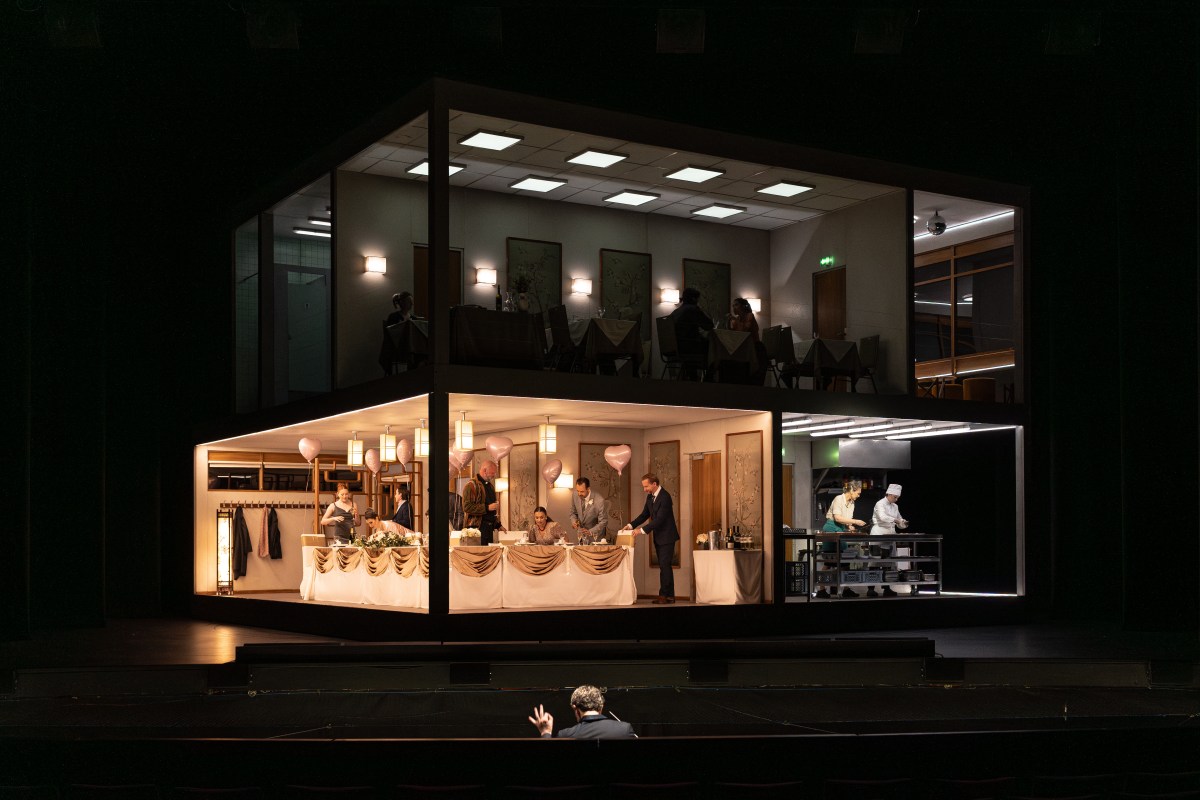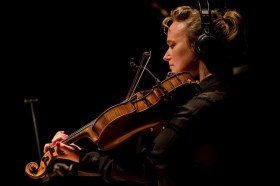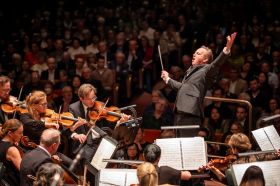Finnish composer Kaija Saariaho’s 2021 opera Innocence was also her final opera. She died at the age of 70 in 2023, as the closing dedicatory surtitle of Simon Stone’s production told us after the last chord had died away.
Saariaho has been described as a ‘spectralist’ composer because of her use of ‘sound spectra’ (visual representations of sound based on mathematical or computer-generated models) as a compositional device. However, the word ‘spectral’ also has appropriately ghostly overtones given the literal and emotional content of the libretto and score of Innocence.
The libretto is by Finnish-Estonian writer Sofi Oksanen, whose previous plays and novels (as well as the operas by other composers and librettists based on them) have focused, like Innocence, on intergenerational trauma, mass violence, sexual abuse and mental illness, as well as similarly interweaving past and present and using multiple narrative points of view. It’s also worth noting that all Saariaho’s operas and Oksanen’s novels and plays have strong female protagonists.
Innocence (the title is clearly ironic) is set during an upper-middle-class wedding reception at a high-end restaurant in Helsinki, but also at an international school where (plot spoiler alert) a mass shooting took place 10 years earlier, as well as kind of indeterminate interzone or ghostly purgatory where survivors and victims remain psychologically or spiritually suspended.
The key character is a last-minute-replacement waitress at the reception who recognises the family and who lost a daughter in the shooting. She confronts the others one by one and eventually tells the bride the truth – with catalytic consequences for everyone.
Other characters include a family friend who is also a priest, a teacher and six students who either survived or were killed (including the waitress’ daughter) and (in Stone’s production at least) seven other students who were killed (and who were played by actors who neither sang nor spoke). There was also a large offstage chorus, who repeated words and phrases in the libretto and at one point listed the names of the victims.
Various singing styles and languages were employed depending on the character and/or the singer, as some of the roles were created in collaboration with particular artists. In addition to Finnish, there was also Czech, Romanian, French, English, German, Spanish and Greek. The main characters slid between singing and Sprechgesang (‘sing-speech’); the students used a rhythmic speech closer to the Sprechstimme (‘spoken-voice’).
A striking exception was the waitress’ dead daughter, who used a style of indigenous Finnish and Sami folk-singing that included vocal leaps and added another dimension of ‘otherness’ to her character (as well as the cultural politics of the story).
The dramatic impetus was heightened by Stone’s brilliant direction and Chloe Lamford’s elegant design.
Innocence was staged inside another two-storey multi-roomed rotating building, which Lamford gave the clean, crisp lines and minimalist, almost featureless, functionality of International Style architecture, and in particular the Finnish modernist architect and designer Alvar Aalto. Interiors and furniture were similarly minimal and featureless (the same could be said for Mel Page’s costumes). James Farncombe’s lighting was cold and pitiless.
The rotating set and minimalist architecture and design facilitated the seamless transitions between restaurant, school and interzone/purgatory, sometimes with multiple rooms visible in different settings; these transitions were stage managed by invisible set changes that occurred backstage as the structure revolved. Gradually the entire building transformed from restaurant to school, including a classroom with rows of desks, a cafeteria with long refectory tables, a bathroom and cupboard in which survivors hide, and bloodstained walls and floors. The rotations then took us back further in time, so that we witnessed the ongoing bullying that eventually provoked the shooting (though there are hints in the libretto that the shooter already showed signs of having a personality disorder) and realised that no one is entirely ‘innocent’ in this story.
The virtuosity of Stone’s direction lay not only in the staging, but also the choreography, which saw singers and actors from all three worlds (restaurant, school and interzone/purgatory) enter and exit the rooms as the latter transitioned from one time and place to another and back again, sometimes with multiple rooms visible in different settings, while the revolve occasionally stopped or changed direction, but the music kept playing. The whole thing was like a cuckoo clock or a merry-go-round in which victims and perpetrators alike were trapped.
Performances were for the most part thrillingly sung (or spoken-voiced) and convincingly acted, with a satisfying tension between the heightened nature of the singing or speaking and the mostly hyper-naturalistic acting style.
In terms of singing and vocal writing, the most moving were the more complex female characters, in particular the Mother-in-Law (French-Canadian soprano Claire de Sévigné), the waitress (Finnish mezzo Jenny Carlstedt), and her dead daughter (Finnish folk singer Erika Hammarberg), who brought an effectively otherworldly quality with her voice and presence.
Musically, French conductor Clément Mao-Takacs kept the Adelaide Symphony on track and rendered a demanding score with clarity and sensitivity, and the State Opera South Australia Chorus (led by Chorus Master Christie Anderson) was eerily effective.
Saariaho was voted ‘greatest living composer’ by her peers in a BBC Music Magazine poll in 2019; and Innocence has been described as her masterwork. It certainly felt as definitive for our time as key modernist operas like Duke Bluebeard’s Castle, Elektra, Erwartung or Wozzeck did a century previously.
Read: Book review: Gutsy Girls, Josie McSkimming
Innocence inherits and transforms that musical and dramatic legacy in the service of a story that expresses our own collective sense of trauma and guilt, social and psychological disintegration and catastrophe. Stone’s production made visible how (to paraphrase Edgar in King Lear) the wheel has come full circle: here we are, again.
Innocence by By Kaija Saariaho
Original Finnish Libretto by Sofi Oksanen and Multilingual Libretto by Aleksi Barrière
Adelaide Chamber Singers and State Opera Chorus
Conductor: Clément Mao Takacs
Director: Simon Stone
Chorus Master: Christie Anderson
Assistant Director: Sybille Wilson
Choreographer: Arco Renz
Lighting Designer: James Farncombe
Costume Designer: Mel Page
Set Designer: Chloe Lamford
Sound Designer: Timo Kurkikangas
Assistant Conductor: Joshua van Konkelenberg
Repetiteurs; Michael Ierace, Joshua van Konkelenberg
Technical Manager: Frédéric Lyonnet
Set up Supervisor: Cyrille Laurent
System Manager: Franck Boulet
Electrician: Maxime Chassang
Stage Manager: Héloïsé Sérazin, Adrien Rigal
Props Manager: Gregory Wattebled
Cast: Jenny Carlstedt, Claire de Sévigné, Tuomas Pursio, Faustine de Monès, Sean Panikkar, Teddy Tahu Rhodes, Lucy Shelton, Erika Hammarberg, Christina Herresthal, Julie Hega, Rowan Kievits, Camilo Delgado Diaz, Marina Dumont
Innocence was performed 28 February-5 March as part of Adelaide Festival.






